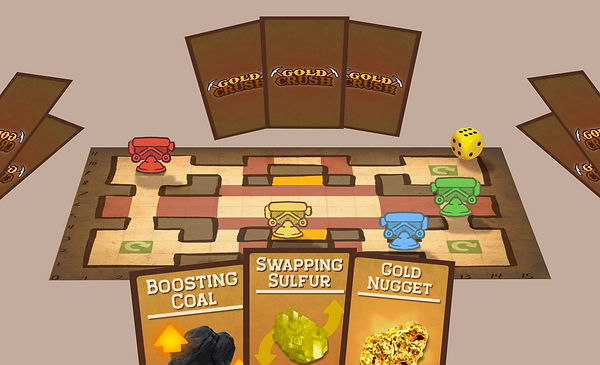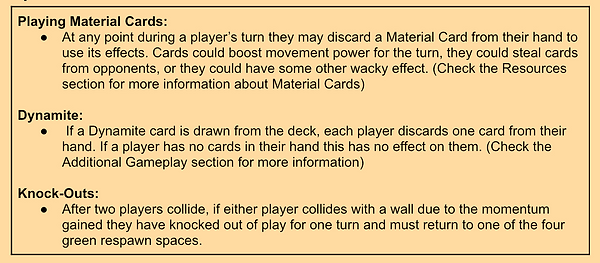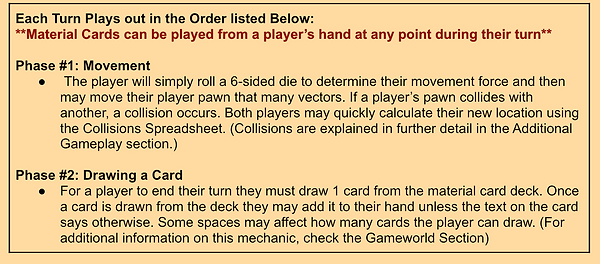
.png)
POSITION
Game Designer, System Designer, Illustrator
DESCRIPTION
Gold Crush is a competitive card game where Up to 4 players will battle it out to see who can collect the most money before the game's end. Players will take turns exploring a grid-based map, colliding with opponents, and collecting special "Material Cards” all in pursuit of victory!
YEAR
Spring 2023
GENRE
Competitive Card Game
PLATFORM
Tabletop Game

Overview
.png)






Introduction
Gold Crush is a competitive card game where Up to 4 players will battle it out to see who can collect the most money before the “Material Card” Deck has been completely drawn through! Players will roll dice to explore the mine and will draw “Material Cards” as they explore. While exploring players can ram into each other to launch their opponents out of advantageous positions. The final element is the Material Cards. Each Material has a wacky effect associated with it, like stealing cards from opponents or boosting the player’s abilities and are drawn from the Material Card Deck. Play will continue until all cards are drawn, and once all cards are gone, players calculate the total cost of all cards in their hand!
Summary
Genre
Party & Card Game
Setting
An abandoned western mining town in the 1800s
Player Format
Competitive, Free-for-All, 2-4 Players
Target Audience
All Ages, Casual Gamers, Party Game Fans
Objective
Explore the gameboard and build a large hand of cards to generate the most money at the game’s end.
Actions
Movement, Drawing Cards, and Playing Cards
Challenges
Actions of Opponents, Randomness, Navigation, and Collisions
Components

Gameboard
x1

Plastic Pawns
x2-4 (Different Colors)
D6 Dice
x2-4 (One for Each Player)
-or-
x1 (Shared Between All Players)
.png)

Deck of "Material Cards"
x1 Deck of 40 Cards

Collision Spreadsheet
x1
Summary
Gameplay
.png)
Procedures & Game Flow

Set-Up

Special Modes

Progression

Resolution
Gameplay Mock-Up

Navigation & Physics
Movement
Collisions
Roll Die

Move Pawn
-
In Gold Crush, players will navigate a Grid-Based game board. Players will roll a D6 to determine their movement power for the turn.
-
The player may move their pawn that many spaces up, down, left, or right. Diagonal movement is not allowed.
-
The player must move the number of spaces they rolled and cannot occupy the same space they started their turn on.
-
If a player chooses to collide with another player during their turn, then the player will stop moving were the collision occurred.

Collision Example
-
If two player’s pawns pass over each other, a collision occurs. When a collision happens, the player who initiated the collision stops moving and is placed on the same space as the pawn they are colliding with.
-
The collided pawn then moves a preset number of spaces back along the axis they were hit on.
-
Both players will reference the collision spreadsheet to determine their new locations post collision.
-
If a player collides with a wall after a collision, the player is knocked out and must return their pawn to a green respawn space.
Card System
-
Material Cards are a resource that is used throughout the game to boost a player’s abilities, disrupt opponents, and generate money at the game’s end.
-
Players may discard cards from their hands to enact a variety of strange effects.
-
Cards with special abilities usually display their effects in a text box.
-
If the "Dynamite!" card is drawn at any point during the game. Normal gameplay temporarily halts, and all players must discard 2 cards.
-
-
Any cards in the player's hand at the end of the game are converted to money.
-
The player with the highest monetary total is the winner at the game's end, so there is risk and reward with every card played.
-
Each Card has a designated cost associated with it, which is written at the bottom of the card.
-












